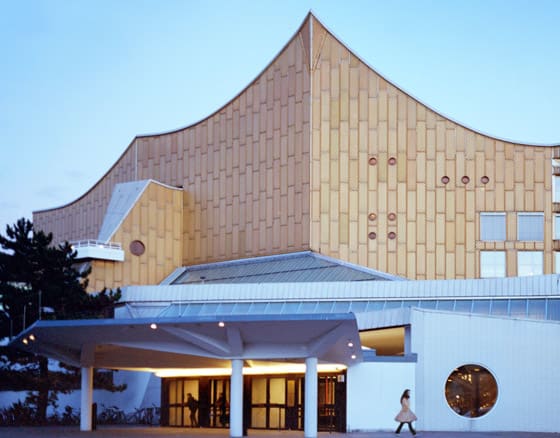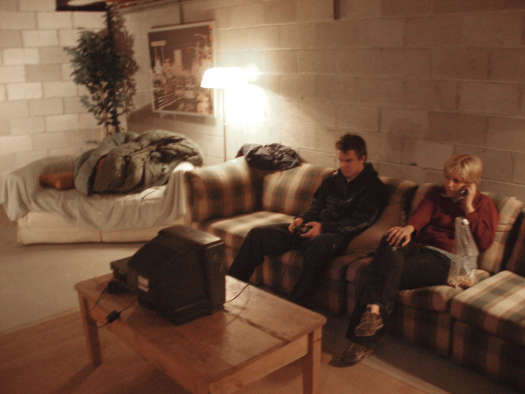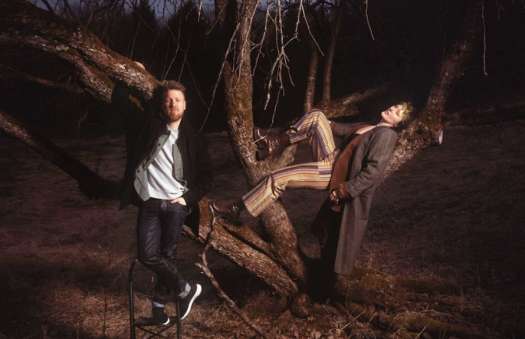At its best, Cathedrals of Culture is a thrilling theatrical experience. Feeling less like a film and more like a miniseries, it bounces from theme to theme and from one dazzling visual style to another as six auteurs try to express the inner soul of buildings around the world, applying radically different uses of 3D to explore the identity of space. If one of 2014's biggest trends was the blurred boundaries between film and television (see miniseries P'tit Quinquin at the top of Cahiers du Cinéma's year-end list), Cathedrals of Culture is certainly among the most decadent long-form experiences this year, clocking in at just under three hours, yet leaving us with the feeling we've just scratched the surface of how to experience space in a new way.
It's rather appropriate that the TIFF Bell Lightbox in Toronto is screening the film at the end of the year when cinephiles are taking stock of how cinema has changed, where the space of the cinema has been challenged by same-day VOD releases and an influx of new home streaming services and ongoing debates about projection technologies. Cathedrals of Culture is decidedly and proudly cinema-specific in its experience, even in spite of its anthology structure. This is a massive, globe-spanning documentary that has only Godard's Goodbye To Language 3D as its peer, challenging previous notions of how 3D can be used to explore space and orient the viewer in previously-unexplored locations within the cinematic landscape.
Wim Wenders' entry kicks things off on a high note, expanding the boundaries of his previous 3D work, Pina, even further. Floating through the dazzling Berlin Philharmonic, Wenders pushes our perceptions of space and depth in exciting new ways, using his camera to lean over balconies and assume multiple positions within the concert hall at the same time. It's a highlight of the anthology, and while using voice-over to create a character in the building seems precocious or trite at first, it reveals itself to be a very handy tool in the film's overall anti-humanist narrativity, forgoing simple narratives of human accomplishment for a more impressionistic exploration of the relationship between space and history, presence and emptiness.
Most of the entries in the film make unique use of 3D to explore these tensions, although a few of them fall into simplistic, determined and overly hegemonic relationships between spaces and their creators, leading to a number of eye-rollingly contrived moments. The film's highs are not without its lower moments, especially in Robert Redford's entry on the Salk Institute in California and Michael Glawogger's entry on the National Library of Russia. Redford's entry feels more like an advertisement for the space, including some shots of scientists posing on balconies that come across as unintentionally hilarious when coupled with Moby's ambient score. Similarly, Glawogger's section never finds a centre to connect history with space in any sort of compelling way. Rather than explore the poetics of architecture, the way in which space and absence come into contact with each other, the weaker moments of Cathedrals of Culture lack any sort of insight into why these spaces are worth exploring.
But at the film's multiple peak, delirious peaks (Danish documentary filmmaker Michael Madsen's entry Norway's Halden Prison and Karim Ainouz's section on Paris's Centre Pompidou), we find an exciting new way of encountering and engaging with space and interior landscapes, a new way of experiencing depth and presence through the use of 3D technology. Here, Cathedrals of Culture reveals itself to be the cinematic equivalent of Yves Bonnefoy's 2009 book The Radiant Space, a work that challenged previous understandings of the poetics of architecture and how any space finds itself in relation to time and presence. Reminiscent of the recent works of Terrence Malick, while remaining entirely unique to the strengths of its six directors, Cathedrals of Culture is an epic accomplishment.
(Neue Road Movies)It's rather appropriate that the TIFF Bell Lightbox in Toronto is screening the film at the end of the year when cinephiles are taking stock of how cinema has changed, where the space of the cinema has been challenged by same-day VOD releases and an influx of new home streaming services and ongoing debates about projection technologies. Cathedrals of Culture is decidedly and proudly cinema-specific in its experience, even in spite of its anthology structure. This is a massive, globe-spanning documentary that has only Godard's Goodbye To Language 3D as its peer, challenging previous notions of how 3D can be used to explore space and orient the viewer in previously-unexplored locations within the cinematic landscape.
Wim Wenders' entry kicks things off on a high note, expanding the boundaries of his previous 3D work, Pina, even further. Floating through the dazzling Berlin Philharmonic, Wenders pushes our perceptions of space and depth in exciting new ways, using his camera to lean over balconies and assume multiple positions within the concert hall at the same time. It's a highlight of the anthology, and while using voice-over to create a character in the building seems precocious or trite at first, it reveals itself to be a very handy tool in the film's overall anti-humanist narrativity, forgoing simple narratives of human accomplishment for a more impressionistic exploration of the relationship between space and history, presence and emptiness.
Most of the entries in the film make unique use of 3D to explore these tensions, although a few of them fall into simplistic, determined and overly hegemonic relationships between spaces and their creators, leading to a number of eye-rollingly contrived moments. The film's highs are not without its lower moments, especially in Robert Redford's entry on the Salk Institute in California and Michael Glawogger's entry on the National Library of Russia. Redford's entry feels more like an advertisement for the space, including some shots of scientists posing on balconies that come across as unintentionally hilarious when coupled with Moby's ambient score. Similarly, Glawogger's section never finds a centre to connect history with space in any sort of compelling way. Rather than explore the poetics of architecture, the way in which space and absence come into contact with each other, the weaker moments of Cathedrals of Culture lack any sort of insight into why these spaces are worth exploring.
But at the film's multiple peak, delirious peaks (Danish documentary filmmaker Michael Madsen's entry Norway's Halden Prison and Karim Ainouz's section on Paris's Centre Pompidou), we find an exciting new way of encountering and engaging with space and interior landscapes, a new way of experiencing depth and presence through the use of 3D technology. Here, Cathedrals of Culture reveals itself to be the cinematic equivalent of Yves Bonnefoy's 2009 book The Radiant Space, a work that challenged previous understandings of the poetics of architecture and how any space finds itself in relation to time and presence. Reminiscent of the recent works of Terrence Malick, while remaining entirely unique to the strengths of its six directors, Cathedrals of Culture is an epic accomplishment.




